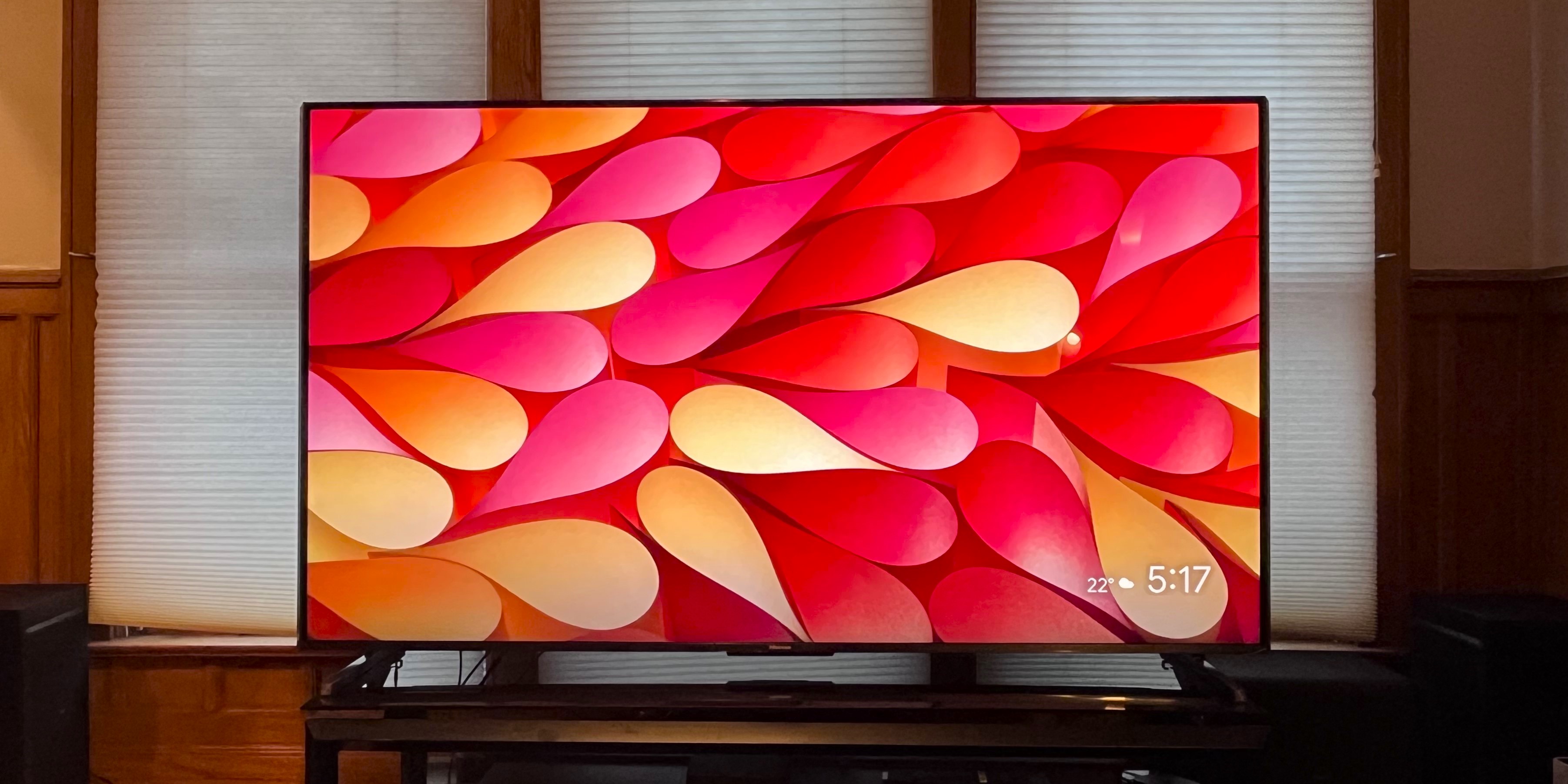TechRadar Verdict
Hisense’s flagship U9N mini-LED TV offers solid picture and sound quality upgrades over the company’s mid-range U8N model. The U9N’s picture is incredibly bright, yet refined, and it’s augmented by a powerful built-in 4.1.2-channel Dolby Atmos speaker system. This TV’s sturdy, yet eye-catching design nicely complements its picture, and a Google TV smart interface with hands-free voice control lets you easily discover things you want to stream. Gaming features and performance aren't as hot as the competition, but overall the U9N is strong high-end TV.
Pros
- +
High brightness and refined local dimming
- +
Powerful 4.1.2-channel speaker system
- +
Excellent off-center picture quality
Cons
- -
Somewhat pricey
- -
Some screen glare
Why you can trust TechRadar
Hisense U9N: Two-minute review
The Hisense U9N arrived on the scene after the rollout of the Hisense U8N, a mid-range mini-LED TV offering exceptional performance and value for money. And while the step-up U9N series is arguably eclipsed by the U8N when it comes to value, it nonetheless offers a noticeable upgrade in picture and sound quality and has a more premium design.
Availability of the Hisense U9N is limited to the US market, where, befitting a premium TV, it is sold in 75-inch ($1,999.99) and 85-inch ($2,999.99) screen sizes. Those prices are a considerable saving on the initial release prices and are notably less than premium mini-LED TV offerings from Samsung and Sony. For this review, I tested the 75-inch U9N.
The U9N’s specs include a mini-LED backlight with up to 5,300 local dimming zones (in the 85-inch model) and a Hi-View Engine X chipset borrowed from the company’s limited edition ULED X series TVs. Along with providing AI-driven picture enhancements, this carries support for the Dolby Vision, HDR10, HDR10+, and HLG high dynamic range formats.
Picture quality on the U9N is stunning. Images are bright, and have exceptional detail and contrast. Colors pop without looking garish, and it has notably better motion handling than other Hisense TVs I’ve tested. But what really sets it apart from the U8N and also lets it compete in the premium mini-LED TV arena is its precise, refined local dimming, which creates deep, uniform-looking blacks with fine gradations of shadow detail. Also, its picture doesn’t lose contrast and color richness when viewed from off-center seats – an important factor for watching with groups.
Sound quality is another U9N strong point. A built-in 4.1.2-channel Dolby Atmos speaker system delivers robust sound with clear positioning of dialogue and effects, along with a decent bass kick. Audio performance is helped by the TV’s design, which positions the left and right speakers in an angled aluminum bezel so they can emit sound directly at the viewer, while the top surface contains upward-firing speakers for Atmos height effects.
As with other Hisense TVs in the US, Google TV is used as a smart TV interface and it’s a flexible and relatively uncluttered platform with a compelling Ambient mode for displaying artwork and photos. Hands-free voice commands are supported, and there’s also a built-in mic on the remote if you don’t want the TV to be set in 'always-listening' mode.
Gaming features on the U9N include dual HDMI 2.1 ports with support for 4K 144Hz, VRR with AMD FreeSync Premium Pro, and Dolby Vision gaming. Input lag is slightly high compared to the best gaming TVs, but that’s not something more casual gamers will notice.
The Hisense U9N ultimately adds up to a great value. It does cost quite a bit more than the step-down Hisense U8N, but if you do have the money to spend, the upgrades it offers are worth it.
Hisense U9N review: Price and release date

- Release date: April 2024
- 75-inch: $2,999
- 85-inch: $3,999
The Hisense U9N is sold in 75- and 85-inch screen sizes, with availability limited to the US market. As a 2024 model, prices for both sizes have dropped since the TVs first shipped, with the 75-inch version now widely available for $1,999.99 and the 85-inch for $2,999,99.
In Hisense’s TV lineup, the U9N series slots in between the mid-range U8N series and the limited-release ULED X series, the latter of which it borrows several features from.
Hisense U9N review: Specs
Screen type: | QLED with Mini-LED |
Refresh rate: | 144Hz |
HDR support: | Dolby Vision, HDR10+, HDR10, HLG |
Audio support: | Dolby Atmos, DTS |
Smart TV: | Google TV |
HDMI ports: | 4 (2x HDMI 2.1) |
Built-in tuner: | ATSC 3.0 |
Hisense U9N review: Benchmark results
Hisense U9N review: Features
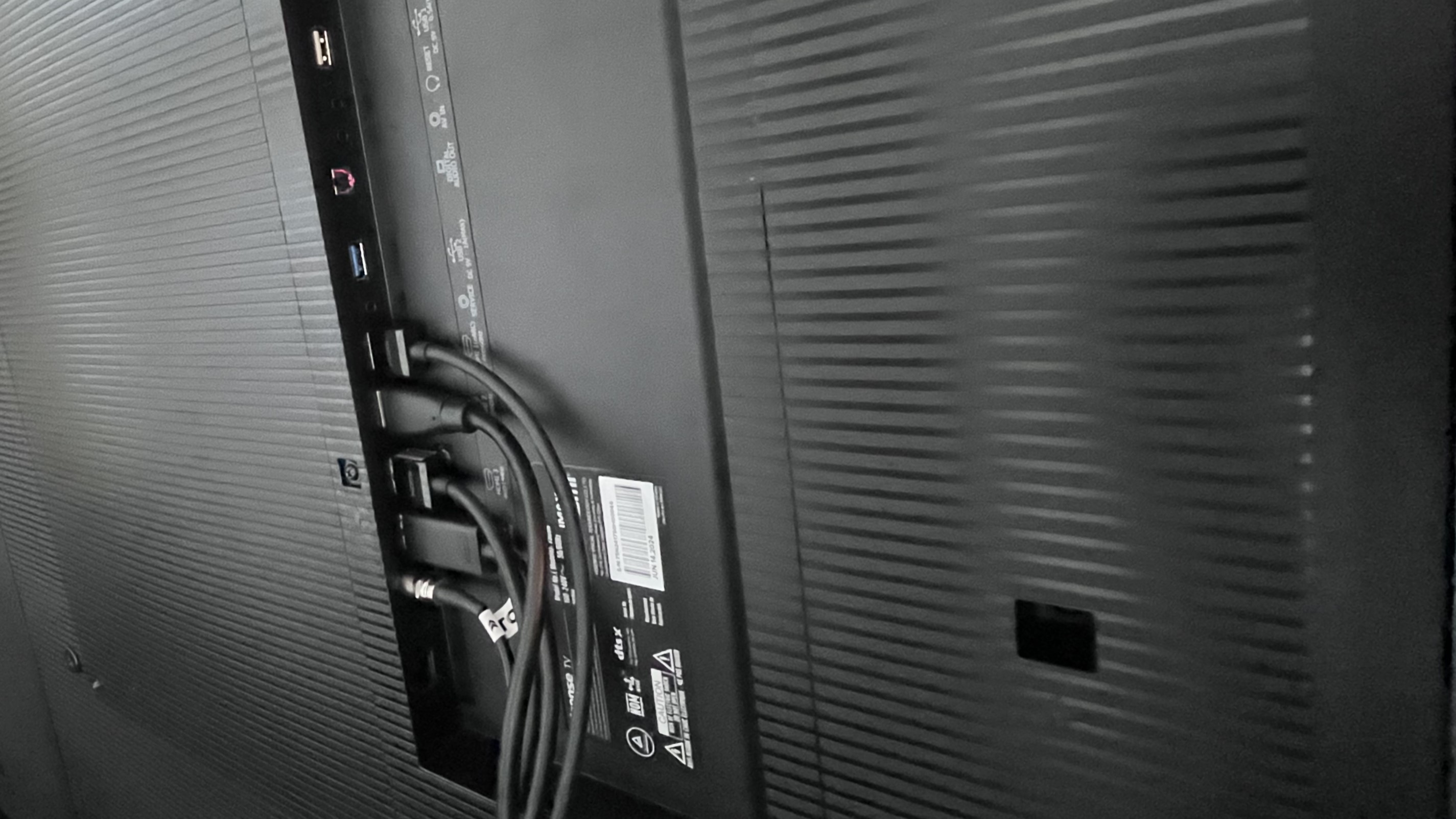
- Mini-LED backlight with up to 5,300 zones
- Dolby Vision and HDR10+ HDR
- Two HDMI 2.1 inputs with 4K 144Hz support
The Hisense U9N features a mini-LED backlight with up to 5,300 local dimming zones (in the 85-inch model). It uses the same Hi-View Engine X chipset found in the company’s limited-edition ULED X series TVs, which features AI-driven scene detection and real-time image enhancement. High dynamic range support includes Dolby Vision, Dolby Vision IQ, HDR10, HDR10+, and HLG, and there’s an ultra-wide viewing angle feature to ensure consistent picture quality when watching from off-center seats.
The 75-inch U9N I tested features a 4.1.2-channel built-in speaker system powered by 76W of amplification that supports Dolby Atmos and DTS:X, along with IMAX Enhanced. The U9N’s thicker-than-average aluminum bezel houses front-firing left and right speakers and there are upwards-firing Atmos height speakers located at the top.
Hisense TVs use the Google TV smart TV interface, and the U9N series also features a built-in mic for hands-free voice control. (Works with Alexa is also supported.) Gaming features include 4K 144Hz support for PC gaming, AMD FreeSync Premium Pro, and Auto Low Latency Mode (ALLM). The U9N’s inputs include two HDMI 2.1 ports, and there’s also an ATSC 3.0 tuner for receiving Next-Gen TV broadcasts.
- Features Score: 4.5/5
Hisense U9N review: Picture quality

- Exceptional brightness, refined local dimming
- Rich color reproduction
- Impressive motion handling
The Hisense U9N’s high brightness levels easily exceed other premium mini-LED TVs such as the Samsung QN90D and Sony Bravia 9. I measured HDR brightness on a 10% HDR white window pattern in Filmmaker Mode at 2,694 nits, while a full-screen HDR white pattern measured 590 nits in the same mode. Those numbers indicate that the U9N can display the full level of highlight detail in most movies and TV shows with HDR without having to resort to tone mapping, and programs like sports will also look good when viewed in bright rooms.
Hisense says the U9N has an anti-reflection screen coating, though I did note some screen glare when viewing with my room’s overhead lights on. One strong picture-quality positive for daytime sports viewing is the U9N’s ultra-wide viewing angle feature, which ensures that pictures had uniform contrast and color saturation even when viewing from far off-center seats – as you might have to do when watching with a crowd of people.
The U9N’s color gamut coverage was also exceptional, measuring 98.9% for UHD-P3 and 81.5% for BT.2020 in Filmmaker Mode. Those results best other premium mini-LED TVs we’ve tested, and rival what you get with the best OLED TVs. Grayscale accuracy in the same mode was less impressive, averaging 3.5 (we normally look for a result under 3), though color accuracy averaged out to an exceptional 1.1.
With its extraordinarily bright picture, the U9N looked fantastic when viewing sports. Watching the Eagles trounce the Chiefs in Super Bowl LIX, the respective green and red hues of the players’ uniforms popped from the screen, and highlights like stadium lights gleaming off helmets gave the image a strong sense of realism and depth. The U9N also did a great job of upscaling the HD picture, making it look near 4K-like.
Darker content such as the Apple TV Plus show Severance also shone on the U9N’s expansive 75-inch screen. Season 2 Episode 4 takes place in a frozen rural landscape, and the U9N rendered details in the wintry scenes with a high level of subtlety. Severance frequently uses monochrome color schemes – blue, especially – for sets and costumes, and the U9N displayed these vividly while also leaving skin tones looking completely natural.
Other scenes from the same Severance episode demonstrated the U9N’s precise local dimming. As the MDR team camps outdoors on a corporate retreat, there are several scenes with campfires being lit and torches wielded at night. On the U9N, these fires blazed against a black background with minimal blooming effects. Even when I checked the blooming torture test clips on the Spears & Munsil Ultra HD Benchmark 4K Blu-ray test disc, I could see only just the faintest signs of backlight blooming.
When I did a hands-on test of a pre-production U9N back in early 2024, I was disappointed with its motion handling. But Hisense clearly made progress on that front with the production version of the U9N, which has no such issue. When I watched a reference scene from Bond film No Time to Die where 007 walks across a craggy mountain cemetery, the picture looked impressively solid, even with no motion processing applied. The U9N's solid motion handling also yielded benefits for sports, which looked fluid yet fully natural.
- Picture quality score: 5/5
Hisense U9N review: Sound quality
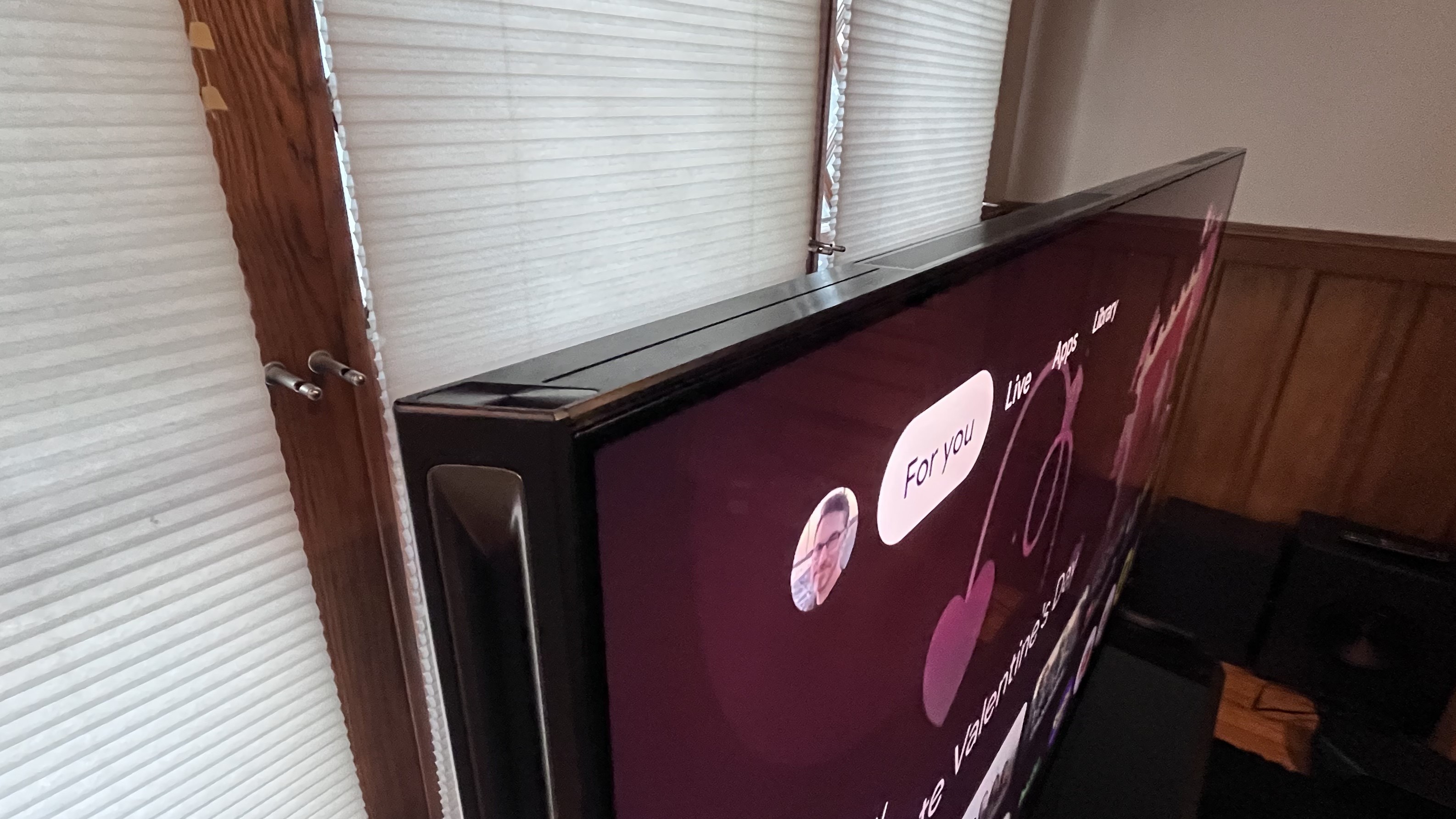
- 4.1.2-channel, 76W speaker system
- Auto Acoustic Tuning feature
- Good height, width with Atmos soundtracks
The U9N features a 4.1.2-channel speaker system powered by 76W. Front left and right drivers are built into the sides of the TV’s substantial aluminum bezel and upwards-firing drivers are located on the screen’s top. Around the back, a pair of built-in bass drivers handle subwoofer duty.
An array of audio adjustments are provided beyond the U9N’s basic sound presets. The Advanced Settings menu has an Auto Acoustic Tuning feature that lets you optimize the TV’s sound output based on measurements taken of your viewing environment using the mic in the remote control. There’s also a multi-band equalizer adjustment, wall-mount compensation, and a subwoofer level adjustment.
The U9N displayed consistently clear dialogue and volume levels could be set fairly high without hearing any distortion. Watching the recent sequel Twisters, in an early scene where the students seed a tornado, only to get caught up in the ensuing turmoil, the sound of wind and loose objects – like vehicles and bodies – blowing around exceeded the screen area and had a good sense of width and height. Shouted dialogue in this sequence also came across clearly, and there was even a decent level of bass thump.
We usually recommend adding one of the best soundbars to any TV, but the U9N could easily stand on its own as long as you’re not overly fussy about home theater sound.
- Sound quality score: 5/5
Hisense U9N review: Design
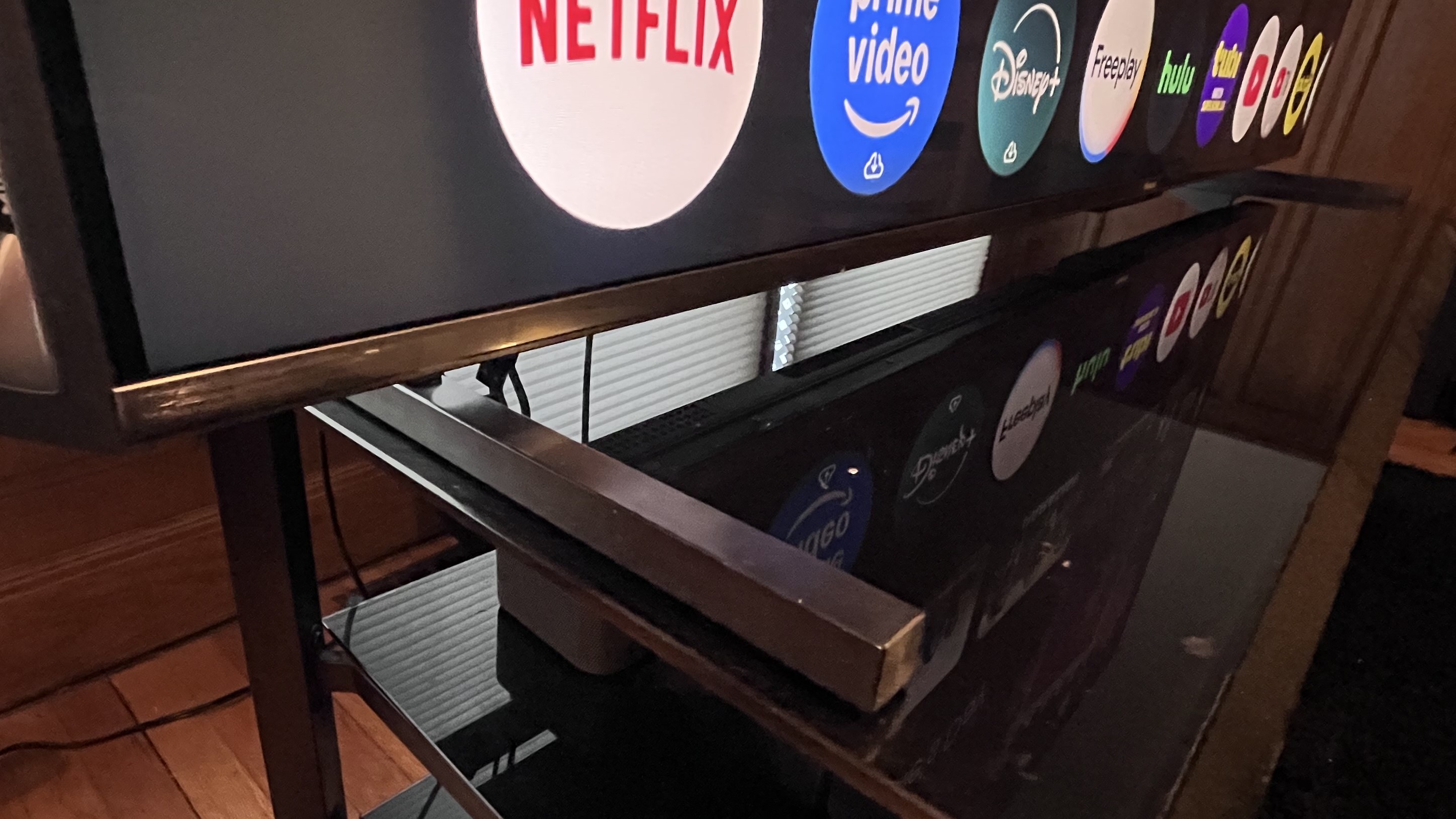
- Widely spaced support feet
- Premium design with angled bezel
- Full-sized, backlit remote control
Unlike other premium (or premium-aspiring) TVs I’ve recently tested, the Hisense U9N opts for widely spaced support feet instead of a pedestal-type base. These barely cleared my 59-inch-wide TV stand, with just a 0.5-inch of space on each side, so make sure you first measure your own stand. The feet provide sturdy support for the TV, though I wished there was a variable height option to clear more space for a soundbar, if you choose one.
The U9N’s bezel is angled on the sides to accommodate the TV’s front-firing speakers. This gives the TV a more premium look than other Hisense TVs, which have a more basic design. Rear panel connections include four HDMI ports (two of which are HDMI 2.1), an optical digital audio output, 3.5mm analog audio input and output jacks, and a pair of USB-A inputs.
Hisense’s full-sized remote control has curved edges and a more solid feel than most other TV remotes. The keypad is backlit and there are buttons to directly access the TV’s quick menu and broadcast channels guide, along with streaming services including Netflix and Disney Plus. A centrally located mic button lets you selectively access Google voice commands when you’ve disabled the TV’s built-in mic.
- Design score: 4.5/5
Hisense U9N review: Smart TV and menus
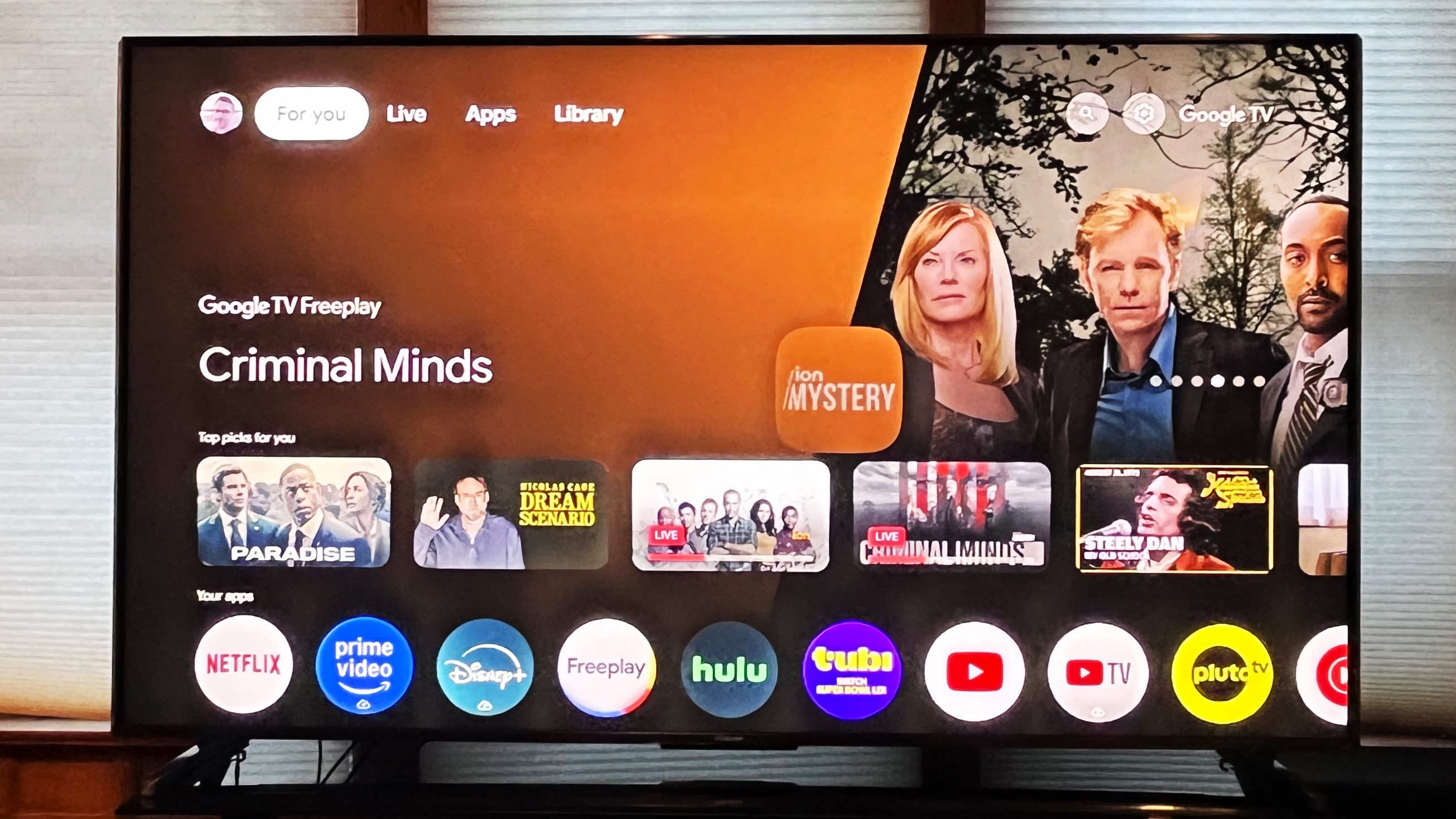
- Google TV with Ambient mode
- Live TV program grid
- Extensive picture adjustments and quick menu
Hisense uses Google TV as the smart interface for all of its TVs in the US. This provides an editable row of apps at the bottom of the home screen, along with a row of suggested content directly above. The suggestions that appear here are based on both your viewing history and Google search history – an arrangement you sign up for when entering your Google account in the TV’s user profile. My only serious issue with Google TV is that you need to create a Google account to download apps from the Google store, and not everyone will necessarily want to participate in the ever-growing Google-verse.
Scrolling down the home screen reveals a range of suggested content categories, while tabs at the top of the screen let you access a Live program guide with both Google Freeplay free TV channels and broadcast channels received by the U9N’s ATSC 3.0 tuner.
A Screensaver option in the TV’s main menu enables you to configure Ambient mode, which kicks in when the TV is on standby. Selections here include an art gallery with Google-curated images, custom-generated AI art, and photos from your personal Google Photos account. You can also add weather and time widgets, which will show up as an overlay on any images in Ambient mode.
Hisense provides extensive picture adjustments in the U9N’s setup menu, with options to have the TV automatically detect content with Filmmaker Mode and IMAX Mode tags, optimize picture settings based on the scene, and upscale standard dynamic range (SDR) programs to high dynamic range (HDR).
A quick menu (called up by pressing the Menu button on the remote) lets you easily switch picture and sound presets, as well as directly access both picture and sound adjustment menus.
- Smart TV & menus score: 4/5
Hisense U9N review: Gaming
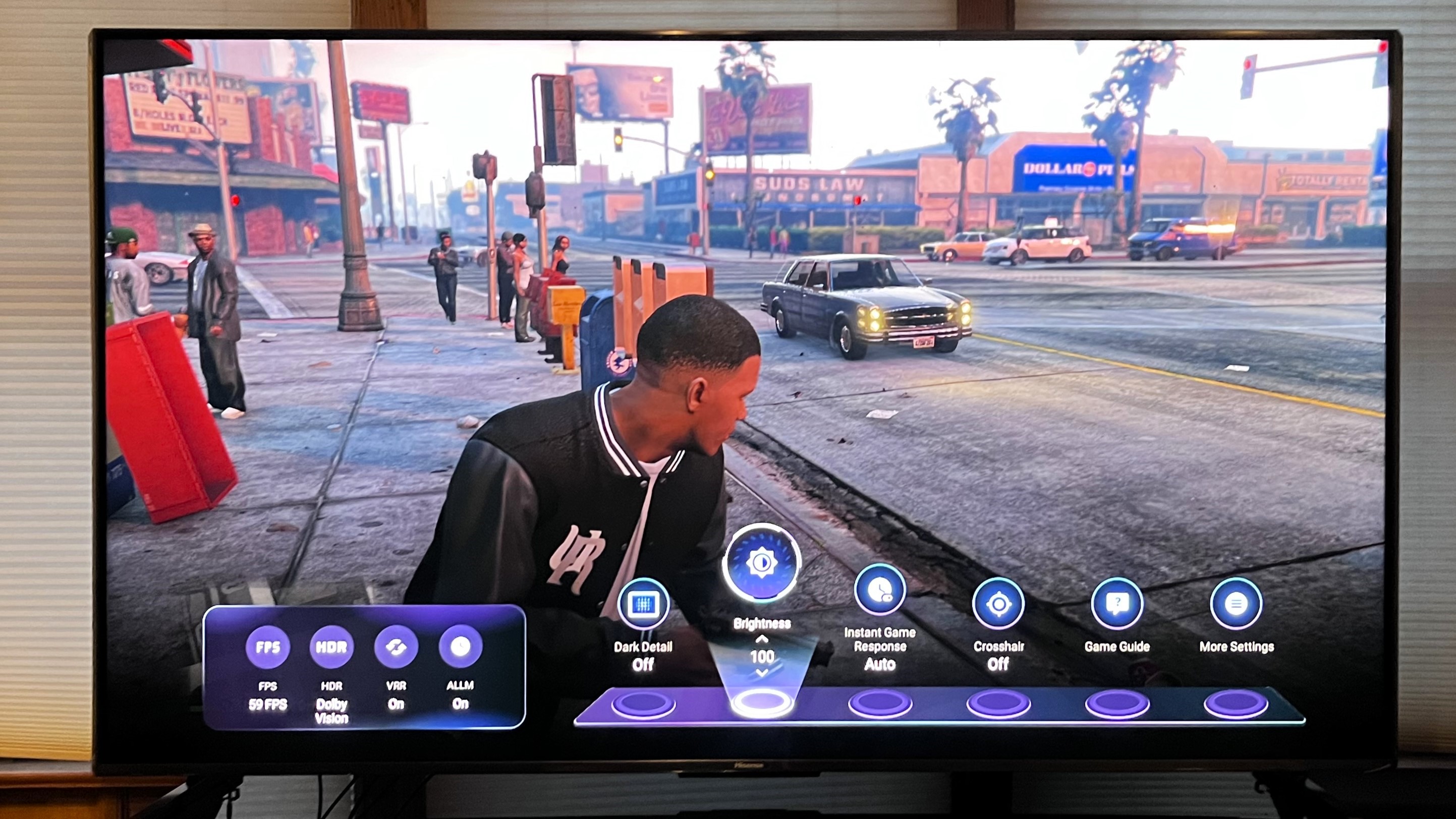
- Two HDMI 2.1 ports
- 4K 144Hz, FreeSync Premium Pro, Dolby Vision gaming
- 15.2ms input lag
The U9N’s dual HDMI 2.1 ports support 4K 144Hz, VRR with AMD FreeSync Premium Pro, and Dolby Vision gaming. We typically ding TVs in reviews for providing only two, rather than four, HDMI 2.1 ports, but an additional HDMI port on the U9N supports HDMI eARC, allowing for both PS5 and Xbox Series X gaming consoles and an external soundbar to be connected all at once, so we can accept it here.
A Game Bar menu (accessible via the quick menu) provides a range of stats and game-related picture and sound adjustments, including genre-specific presets, when the TV is in Game mode.
At 15.2ms, the U9N’s input lag in Game mode is on the high side compared to the best gaming TVs, though I didn’t notice any issues during casual gaming with an Xbox Series X.
- Gaming score: 4/5
Hisense U9N review: Value
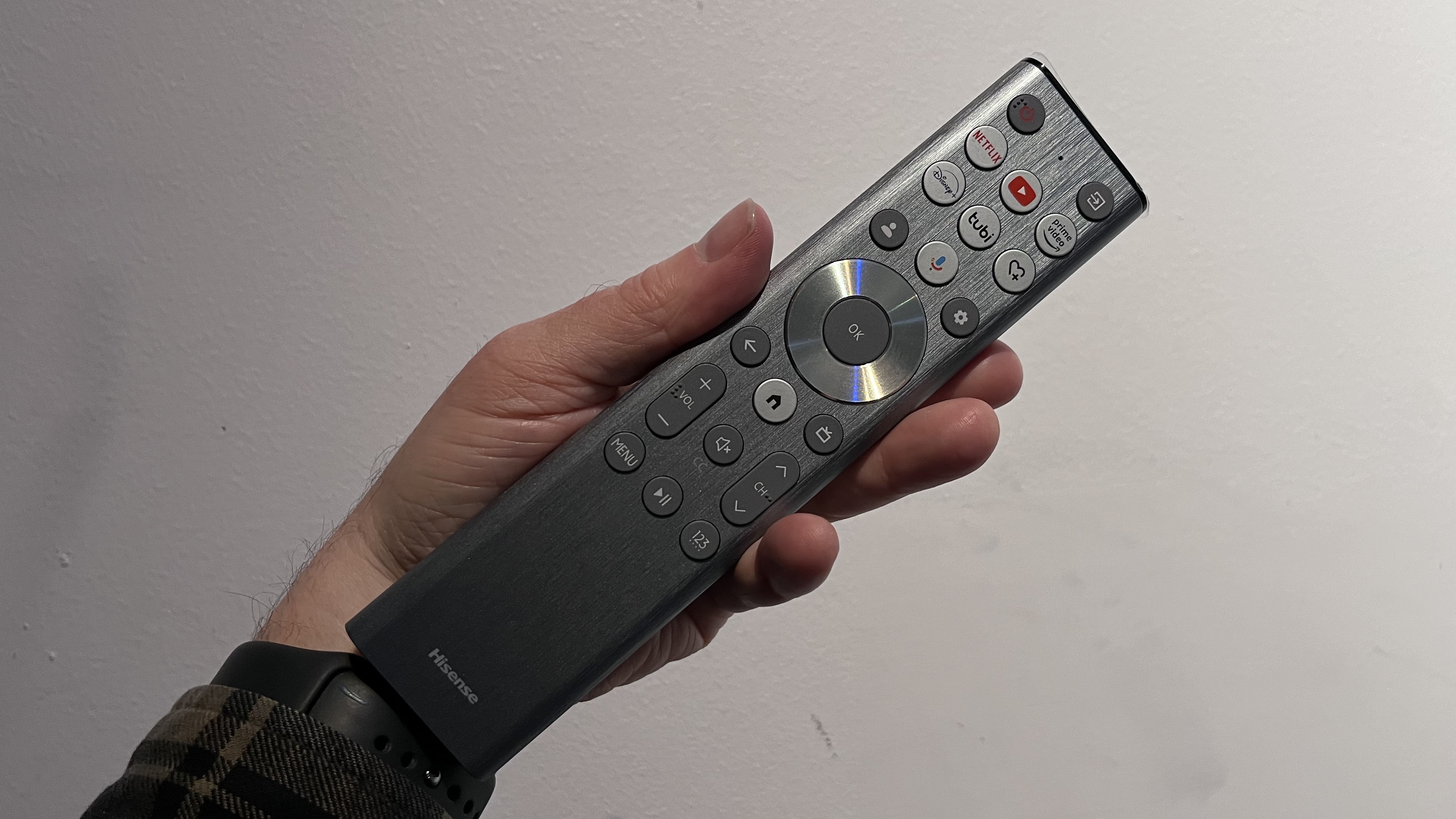
- Priced lower than premium mini-LED competition
- Cheaper Hisense U8N series is also excellent
- Still, a great overall value
At around $2,000, the 75-inch Hisense U9N is priced lower than its closest mini-LED competition when it comes to picture and sound quality. You can buy the Samsung QN90D in a 75-inch screen size for around $2,400, while the Sony Bravia 9 will cost you around $3,500. Taken in that company, the U9N is an exceptional value.
The main thing that chips away at the U9N’s value is the also-excellent Hisense U8N (around $1,299 for the 75-inch screen size), which has an even brighter picture than the U9N plus similar gaming features and performance. You get a more refined local dimming with the U9N, however, along with better P3 color space coverage and superior off-axis picture performance. The U9N’s 4.1.2-channel speakers also deliver more powerful and immersive sound than the U8N’s 2.1.2-channel speakers.
All things considered, the Hisense U9N still stands out as a great value, and one well worth considering even at a $700 premium over the Hisense U8N.
- Value score: 4.5/5
Should I buy the Hisense U9N?
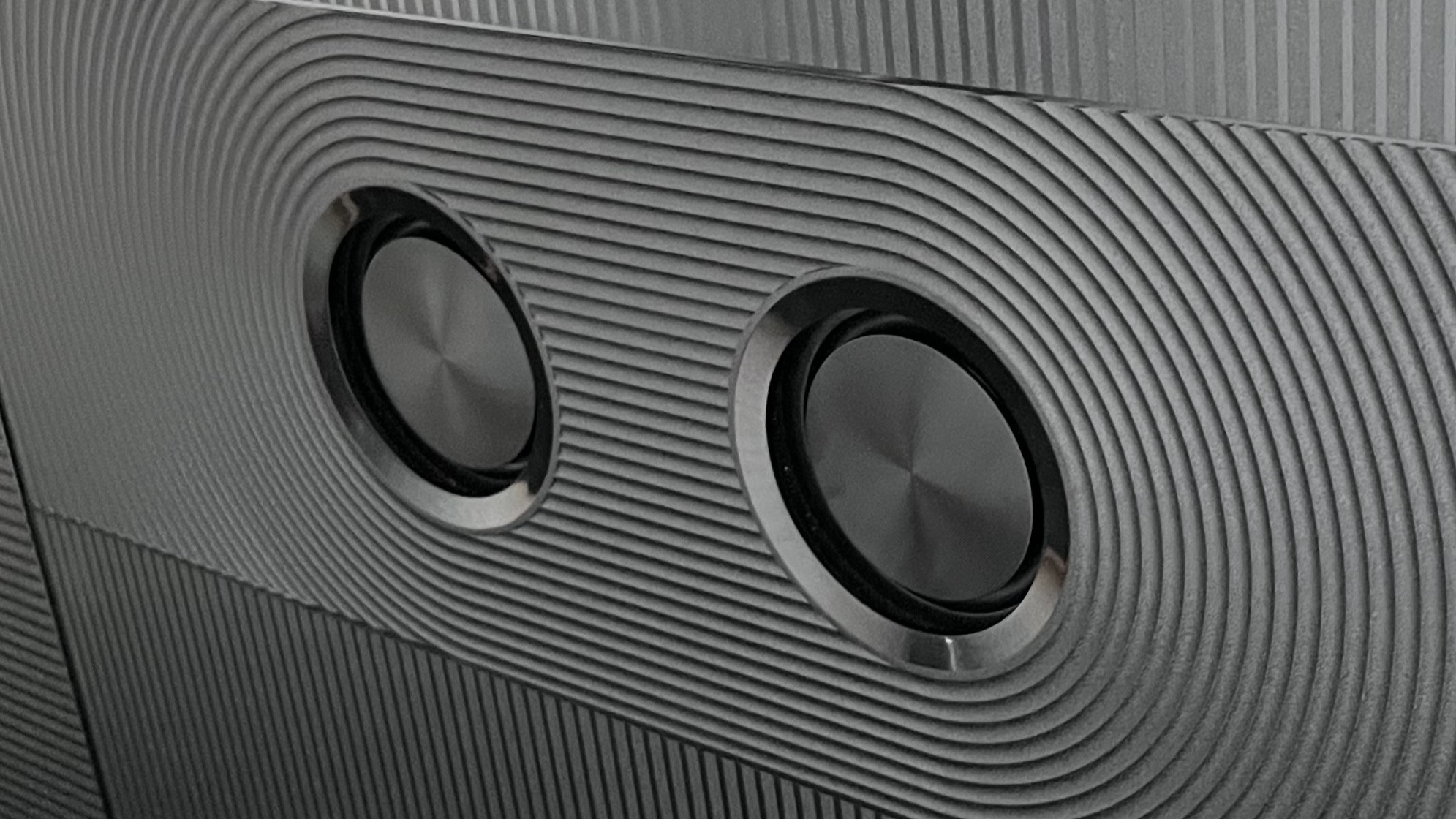
Attributes | Notes | Rating |
|---|---|---|
Features | Mini-LED backlight with up to 5,300 local dimming zones; 4.1.2-channel Dolby Atmos speakers. | 4.5/5 |
Picture quality | High brightness and excellent all-around picture quality. | 5/5 |
Sound quality | Powerful, spacious sound with good bass. | 5/5 |
Design | Sturdy design with angled bezel and widely spaced support feet. | 4.5/5 |
Smart TV and menus | Google TV a solid smart interface, and is accompanied here by plentiful picture and sound settings. | 4/5 |
Gaming | Good gaming feature package but only two HDMI 2.1 ports and slightly high input lag. | 4/5 |
Value | Somewhat pricey, but a great value for a premium mini-LED TV. | 4.5/5 |
Buy it if...
You want to watch in bright rooms
The U9N’s high brightness and excellent off-axis picture picture quality make it a perfect choice for viewing sports in bright rooms and with large groups.
…and also want a great TV for movies
The U9N’s refined local dimming and versatile handling of programs with high dynamic range makes it great for viewing movies and TV shows in HDR.
You want great built-in sound
A 4.1.2-channel, 76W speaker system with front- and upward-firing drivers lets the U9N project loud, clean and immersive sound with good bass.
Don't buy it if…
You want the best gaming TV
The U9N has better-than-average gaming features and good gaming performance, but other TVs best it when it comes to measured input lag as well as offering extras like cloud gaming.
You’re on a budget
While the U9N is easy to recommend, Hisense’s U8N also delivers great overall performance and a mostly similar feature set at a much lower price.
Panasonic Z95A review: Also consider...
| Header Cell - Column 0 | Hisense U9N | Samsung QN90D | Sony Bravia 9 | Hisense U8N |
|---|---|---|---|---|
Price (75-inch) | $1,999 | $2,399 | $3,499 | $1,299 |
Screen type | QLED with mini-LED | QLED with mini-LED | QLED with mini-LED | QLED with mini-LED |
Refresh rate | 144Hz | 144Hz | 144Hz | 144Hz |
HDR support | Dolby Vision/HDR10+/HDR10/HLG | HDR10+/HDR10/HLG | HDR10+/HDR10/HLG | Dolby Vision/HDR10+/HDR10/HLG |
Smart TV | Google TV | Tizen | Google TV | Google TV |
HDMI ports | 4 (2x HDMI 2.1) | 4 x HDMI 2.1 | 4 (2x HDMI 2.1) | 4 (2x HDMI 2.1) |
Samsung QN90D
Samsung’s flagship mini-LED TV costs more than the U9N and doesn’t support the Dolby Vision HDR format. Its picture quality is equally good, however, and it also has a sleeker design and better gaming features, as we found in our Samsung QN90D review.
Sony Bravia 9
Sony’s flagship TV is about as premium as mini-LED gets, and we appreciated its bright yet refined picture and powerful sound in our Sony Bravia 9 review. But, it’s considerably more expensive than the U9N and lacks the Hisense’s HDR10+ support.
Hisense U8N
The step-down series from the U9N in Hisense’s TV lineup, the U8N has a nearly as good picture along with impressive sound quality. It’s also an exceptional value as we said in our Hisense U8N review.
How I tested the Hisense U9N
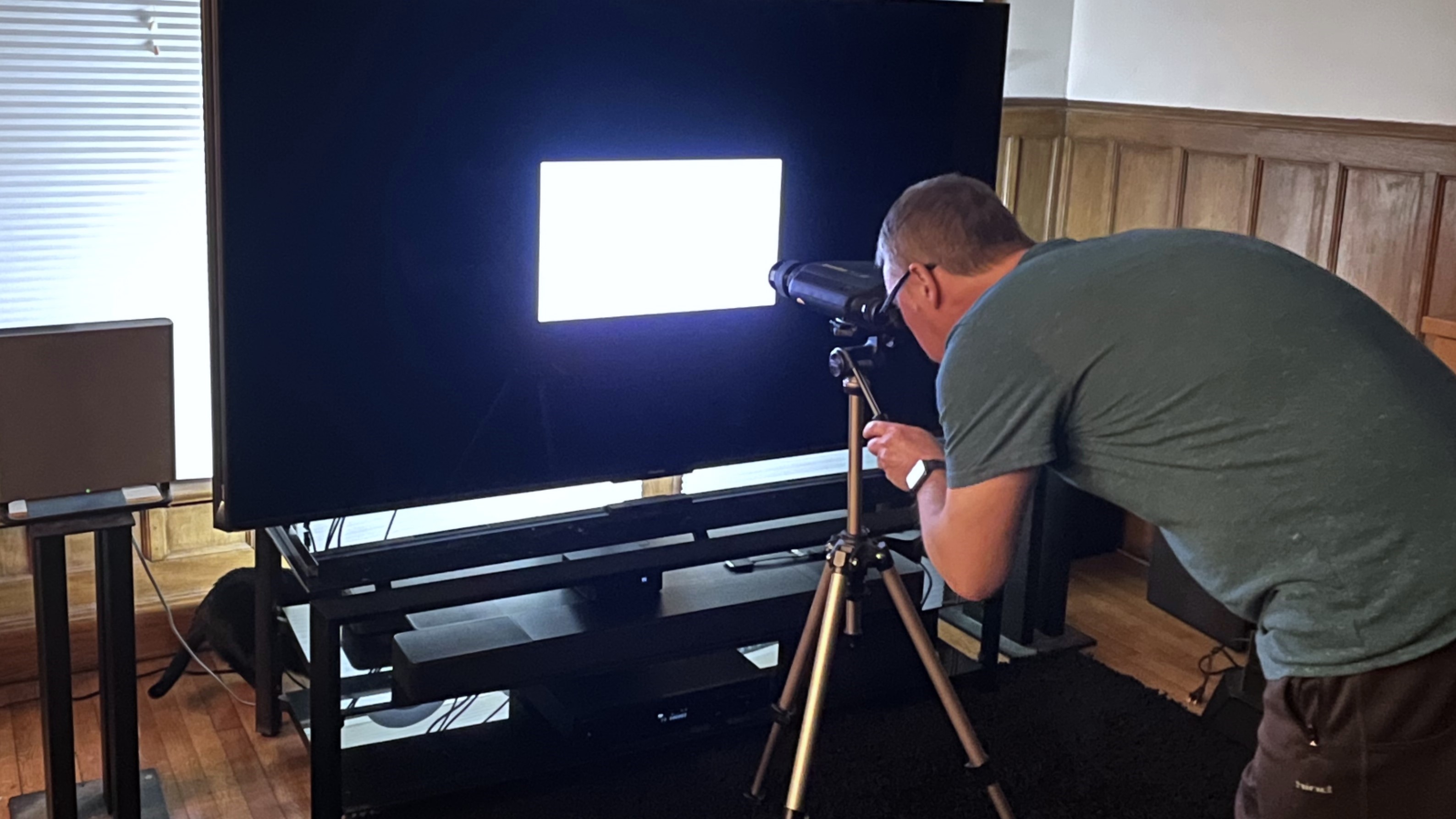
- Tested over the course of two weeks
- Measurements were made using Calman color calibration software
- A full calibration was made before proceeding with subjective tests
When I tested the Hisense U9N, I first spent a few weeks using it for casual viewing to assess the out-of-box picture presets and get familiar with its smart TV menu and picture adjustments. I next selected the most accurate preset (Filmmaker Mode, in this case) and measured grayscale and color accuracy using Portrait Displays’ Calman color calibration software. The resulting measurements provide Delta-E values (the margin of error between the test pattern source and what’s shown on-screen) for each category and allow for an assessment of the TV’s overall accuracy.
Along with those tests, I made measurements of peak light output (recorded in nits) for both standard high-definition and 4K high dynamic range using 10% and 100% white window patterns. Coverage of DCI-P3 and BT.2020 color space was also measured, with the results providing a sense of how faithfully the U9N can render the extended color range in ultra high-definition sources.
I used the Calman ISF workflow, along with the TV’s advanced picture menu settings, to calibrate the image for best accuracy after I'd assessed its out-of-the-box performance. I also watched a range of reference scenes on 4K Blu-ray discs to assess the TV’s performance, and 4K HDR shows streamed from Max, Hulu, and other services.
You can read an in-depth overview of how we test TVs at TechRadar for more information.
- First reviewed: February 2025
- Read TechRadar's reviews guarantee

Al Griffin has been writing about and reviewing A/V tech since the days LaserDiscs roamed the earth, and was previously the editor of Sound & Vision magazine.
When not reviewing the latest and greatest gear or watching movies at home, he can usually be found out and about on a bike.
You must confirm your public display name before commenting
Please logout and then login again, you will then be prompted to enter your display name.
